sensor TOYOTA LAND CRUISER 2017 J200 Quick Reference Guide
[x] Cancel search | Manufacturer: TOYOTA, Model Year: 2017, Model line: LAND CRUISER, Model: TOYOTA LAND CRUISER 2017 J200Pages: 54, PDF Size: 6.52 MB
Page 3 of 54
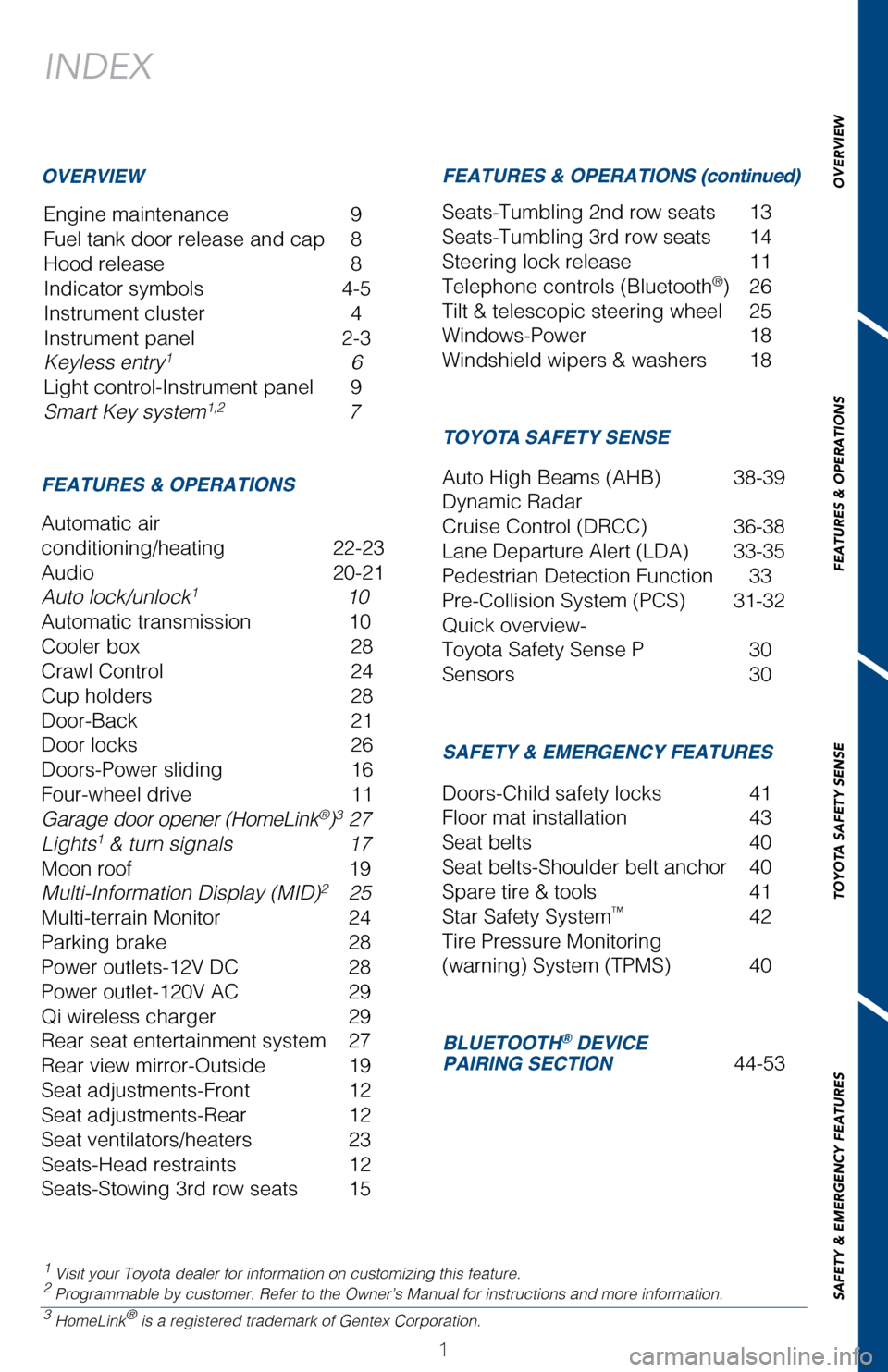
OVERVIEW
FEATURES & OPERATIONS
TOYOTA SAFETY SENSE
SAFETY &
EMERGENCY FEATURES
1
INDEX
Engine maintenance 9
Fuel tank door release and cap 8
Hood release 8
Indicator symbols 4-5
Instrument cluster 4
Instrument panel 2-3
Keyless entry
1 6
Light control-Instrument panel 9
Smart Key system
1,2 7
1 Visit your Toyota dealer for information on customizing this feature.2 Programmable by customer. Refer to the Owner’s Manual for instructio\
ns and more information.3 HomeLink® is a registered trademark of Gentex Corporation.
OVERVIEW
FEATURES & OPERATIONS FEATURES & OPERATIONS (continued)
SAFETY & EMERGENCY FEATURES TOYOTA SAFETY SENSE
Automatic air
conditioning/heating
22-23
Audio 20-21
Auto lock/unlock
1 10
Automatic transmission 10
Cooler box 28
Crawl Control 24
Cup holders 28
Door-Back 21
Door locks 26
Doors-Power sliding 16
Four-wheel drive 11
Garage door opener (HomeLink
®)3 27
Lights1 & turn signals 17
Moon roof 19
Multi-Information Display (MID)
2 25
Multi-terrain Monitor 24
Parking brake 28
Power outlets-12V DC 28
Power outlet-120V AC 29
Qi wireless charger 29
Rear seat entertainment system 27
Rear view mirror-Outside 19
Seat adjustments-Front 12
Seat adjustments-Rear 12
Seat ventilators/heaters 23
Seats-Head restraints 12
Seats-Stowing 3rd row seats 15 Seats-Tumbling 2nd row seats 13
Seats-Tumbling 3rd row seats 14
Steering lock release
11
Telephone controls (Bluetooth
®) 26
Tilt & telescopic steering wheel 25
Windows-Power 18
Windshield wipers & washers 18
Doors-Child safety locks 41
Floor mat installation 43
Seat belts 40
Seat belts-Shoulder belt anchor 40
Spare tire & tools 41
Star Safety System
™ 42
Tire Pressure Monitoring
(warning) System (TPMS) 40
Auto High Beams (AHB) 38-39
Dynamic Radar
Cruise Control (DRCC) 36-38
Lane Departure Alert (LDA) 33-35
Pedestrian Detection Function 33
Pre-Collision System (PCS) 31-32
Quick overview-
Toyota Safety Sense P 30
Sensors 30
BLUETOOTH® DEVICE
PAIRING SECTION 44-53
Page 20 of 54
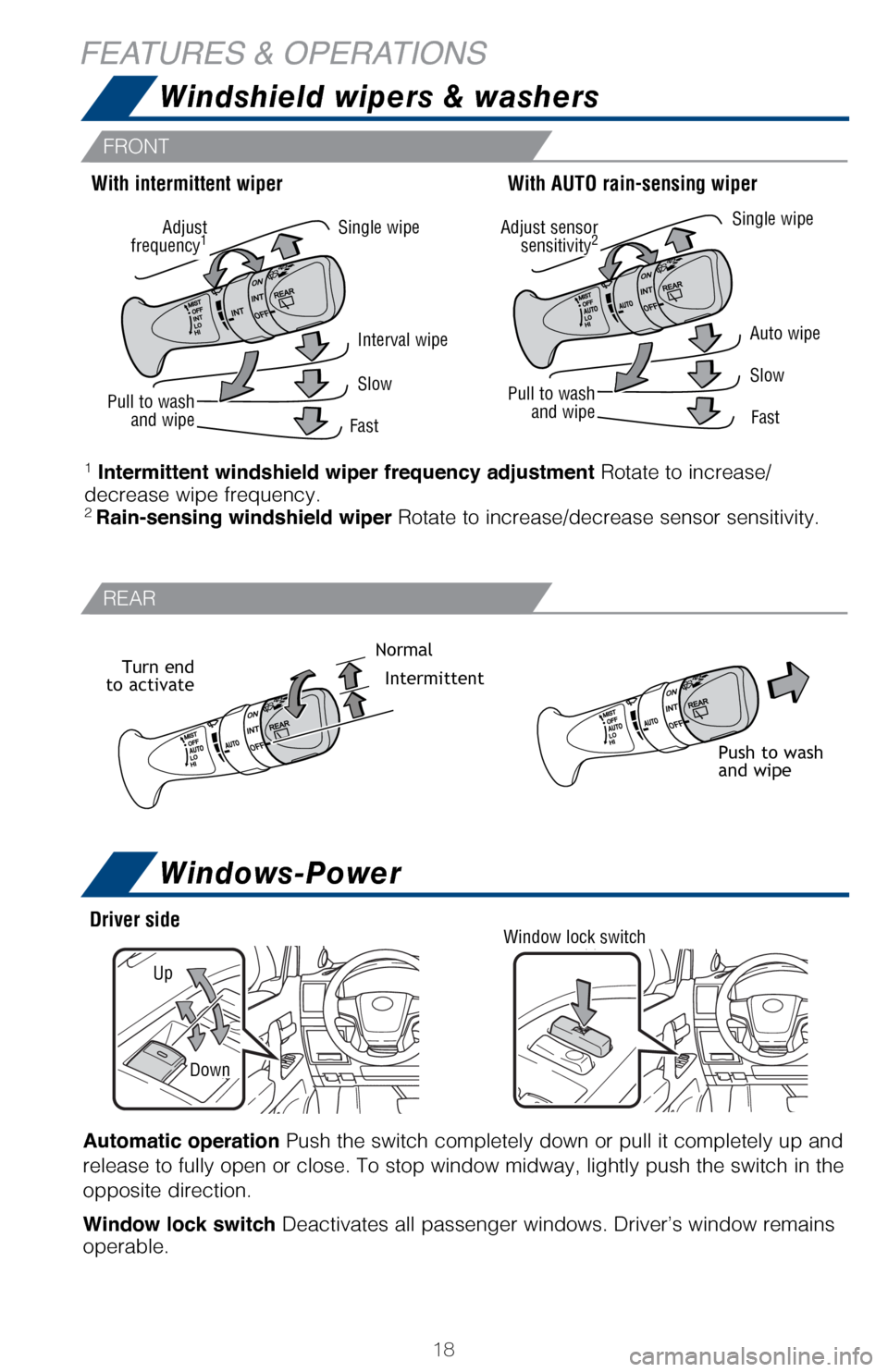
18
FEATURES & OPERATIONS
Up
Down
Driver sideWindow lock switch
Automatic operation Push the switch completely down or pull it completely up and
release to fully open or close. To stop window midway, lightly push the \
switch in the
opposite direction.
Window lock switch Deactivates all passenger windows. Driver’s window remains
operable.
Intermittent
Normal
Adjust sensor sensitivity2
Pull to wash and wipe
Push to wash
and wipe
Single wipe
Auto wipe
Slow
Fast
1 Intermittent windshield wiper frequency adjustment Rotate to increase/
decrease wipe frequency.
2 Rain-sensing windshield wiper Rotate to increase/decrease sensor sensitivity.
With intermittent wiper
With AUTO rain-sensing wiper
Pull to wash
and wipe
Single wipe
Interval wipe
Slow
Fast
Adjust
frequency1
Turn end
to activate
FRONT
REAR
Windshield wipers & washers
Windows-Power
Page 32 of 54

30
Quick overview-Toyota Safety Sense P
Sensors
Toyota Safety Sense (TSS) P is a set of active safety technologies des\
igned to
help prevent or mitigate collisions across a wide range of traffic situa\
tions. TSS-P
is designed to help support the driver’s awareness, decision making a\
nd vehicle
operation contributing to a safe and comfortable driving experience.Pre-Collision System (PCS)
Provides collision avoidance or damage mitigation support
when the system detects that a potential collision is likely to
occur.
Lane Departure Alert (LDA)
Provides notification when the system detects an unintended
lane departure.
Auto High Beams (AHB)
Designed to detect the headlights of oncoming vehicles and
the tail lights of preceding vehicles and switch between high
beams and low beams as appropriate.
Pedestrian Detection Function
Advanced sensor system helps to recognize pedestrians and
provide collision avoidance support.
Dynamic Radar Cruise Control (DRCC)
Helps maintain a pre-set distance to a preceding vehicle when
the preceding vehicle is traveling at a lower speed.
Refer to the Owner’s Manual for more details to understand these func\
tions and
complete safety precautions before attempting to use any of TOYOTA SAFET\
Y
SENSE P functions.
TSS-P Combines an in-vehicle camera mounted in front of the inside rear \
view
mirror and a millimeter-wave radar mounted in the front grill. These sen\
sors support
the driver assist systems.
Radar sensor Camera sensor
TOYOTA SAFETY SENSE
Page 33 of 54
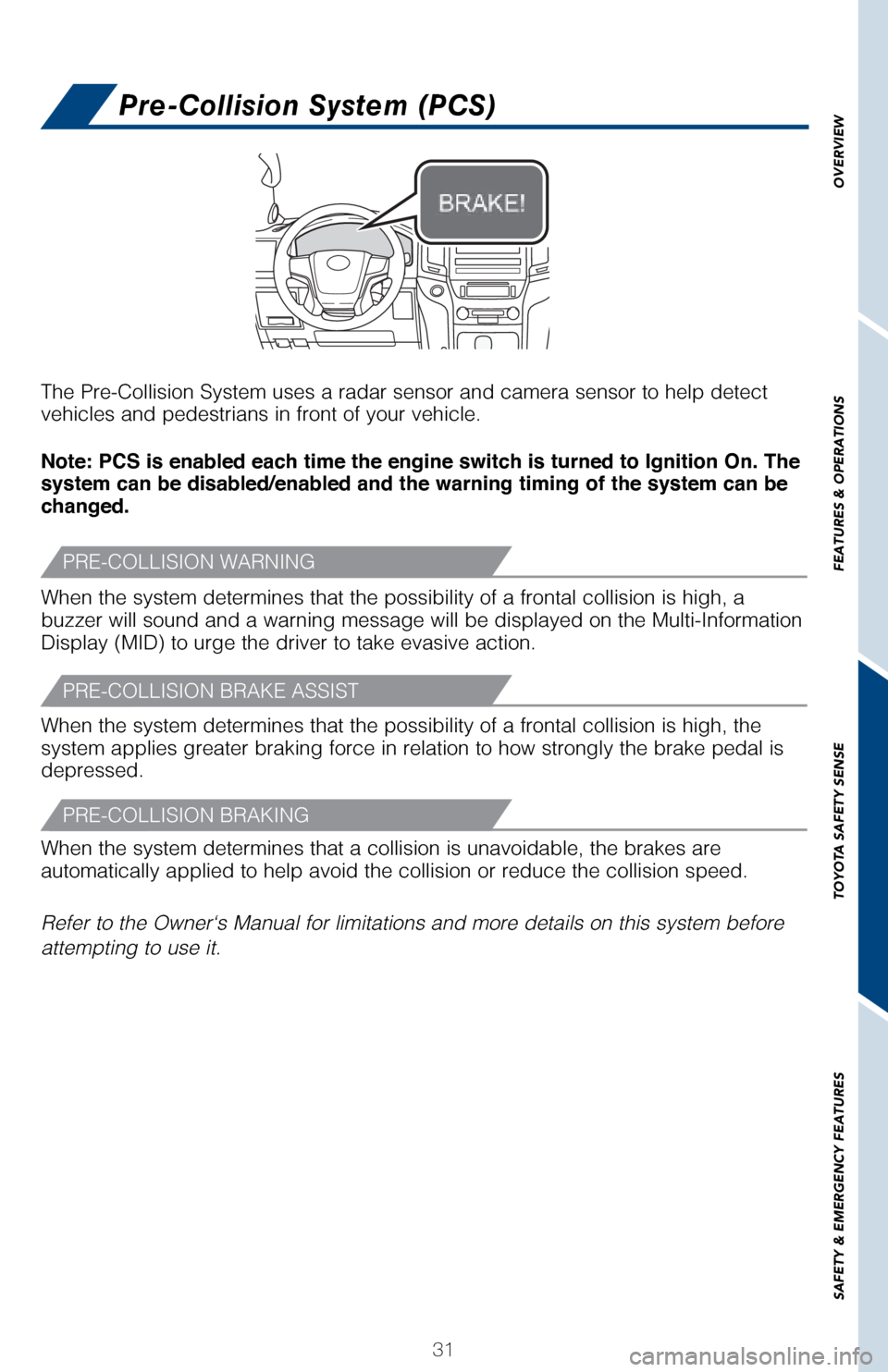
31
OVERVIEW
FEATURES & OPERATIONS
TOYOTA SAFETY SENSE
SAFETY & EMERGENCY FEATURES
PRE-COLLISION WARNING
PRE-COLLISION BRAKE ASSIST
PRE-COLLISION BRAKING
Pre-Collision System (PCS)
The Pre-Collision System uses a radar sensor and camera sensor to help d\
etect
vehicles and pedestrians in front of your vehicle.
Note: PCS is enabled each time the engine switch is turned to Ignition On. The
system can be disabled/enabled and the warning timing of the system can be
changed.
Refer to the Owner‘s Manual for limitations and more details on this \
system before
attempting to use it. When the system determines that the possibility of a frontal collision i\
s high, a
buzzer will sound and a warning message will be displayed on the Multi-I\
nformation
Display (MID) to urge the driver to take evasive action.
When the system determines that the possibility of a frontal collision i\
s high, the
system applies greater braking force in relation to how strongly the bra\
ke pedal is
depressed.
When the system determines that a collision is unavoidable, the brakes a\
re
automatically applied to help avoid the collision or reduce the collisio\
n speed.
Page 35 of 54
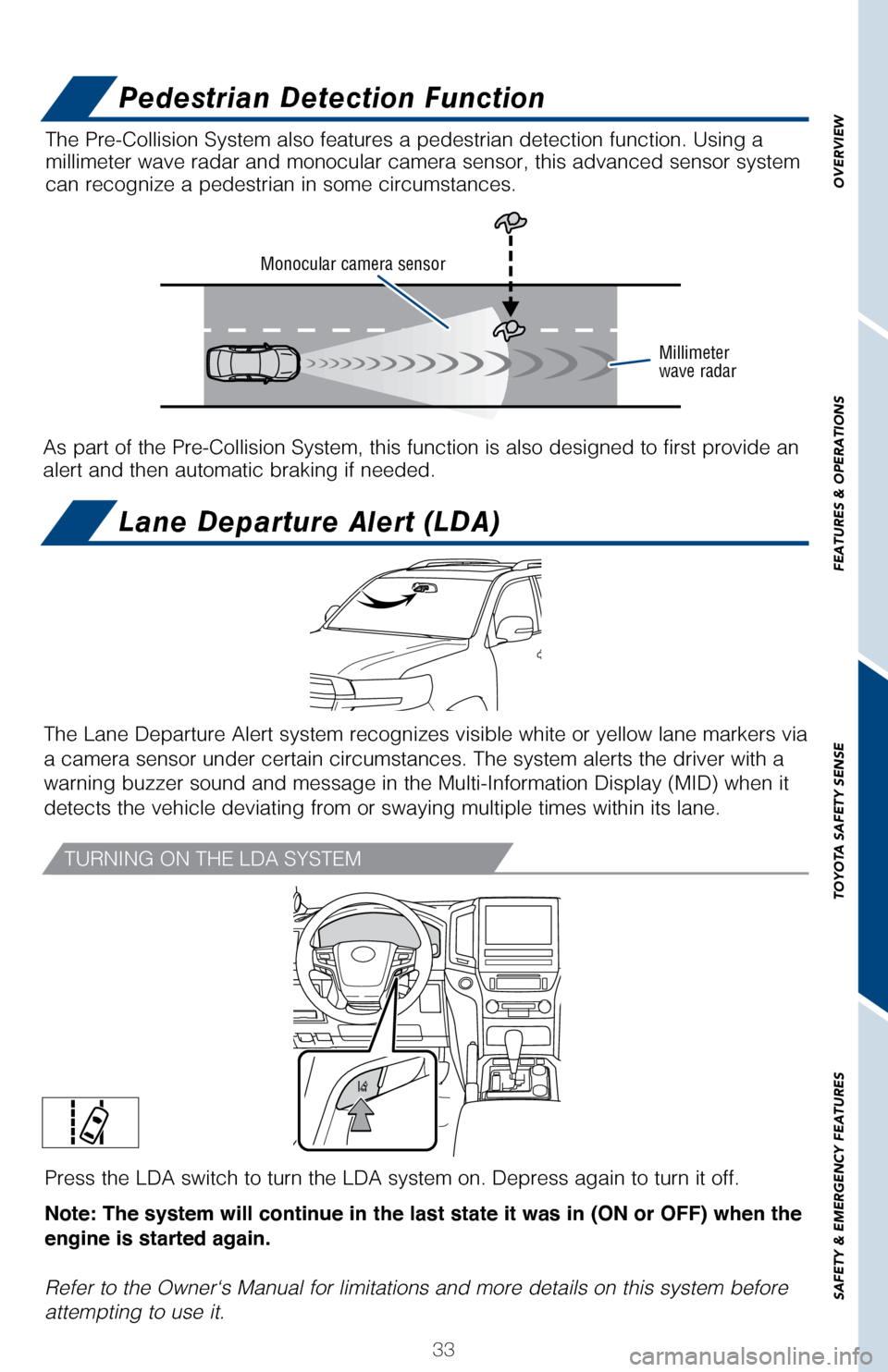
33
OVERVIEW
FEATURES & OPERATIONS
TOYOTA SAFETY SENSE
SAFETY & EMERGENCY FEATURES
Pedestrian Detection Function
Lane Departure Alert (LDA)
TURNING ON THE LDA SYSTEM
Monocular camera sensor
Millimeter
wave radar
As part of the Pre-Collision System, this function is also designed to f\
irst provide an
alert and then automatic braking if needed.The Pre-Collision System also features a pedestrian detection function. \
Using a
millimeter wave radar and monocular camera sensor, this advanced sensor \
system
can recognize a pedestrian in some circumstances.
Press the LDA switch to turn the LDA system on. Depress again to turn it\
off.
Note: The system will continue in the last state it was in (ON or OFF) when the
engine is started again.
Refer to the Owner‘s Manual for limitations and more details on this \
system before
attempting to use it.
The Lane Departure Alert system recognizes visible white or yellow lane \
markers via
a camera sensor under certain circumstances. The system alerts the drive\
r with a
warning buzzer sound and message in the Multi-Information Display (MID)\
when it
detects the vehicle deviating from or swaying multiple times within its \
lane.
Page 39 of 54
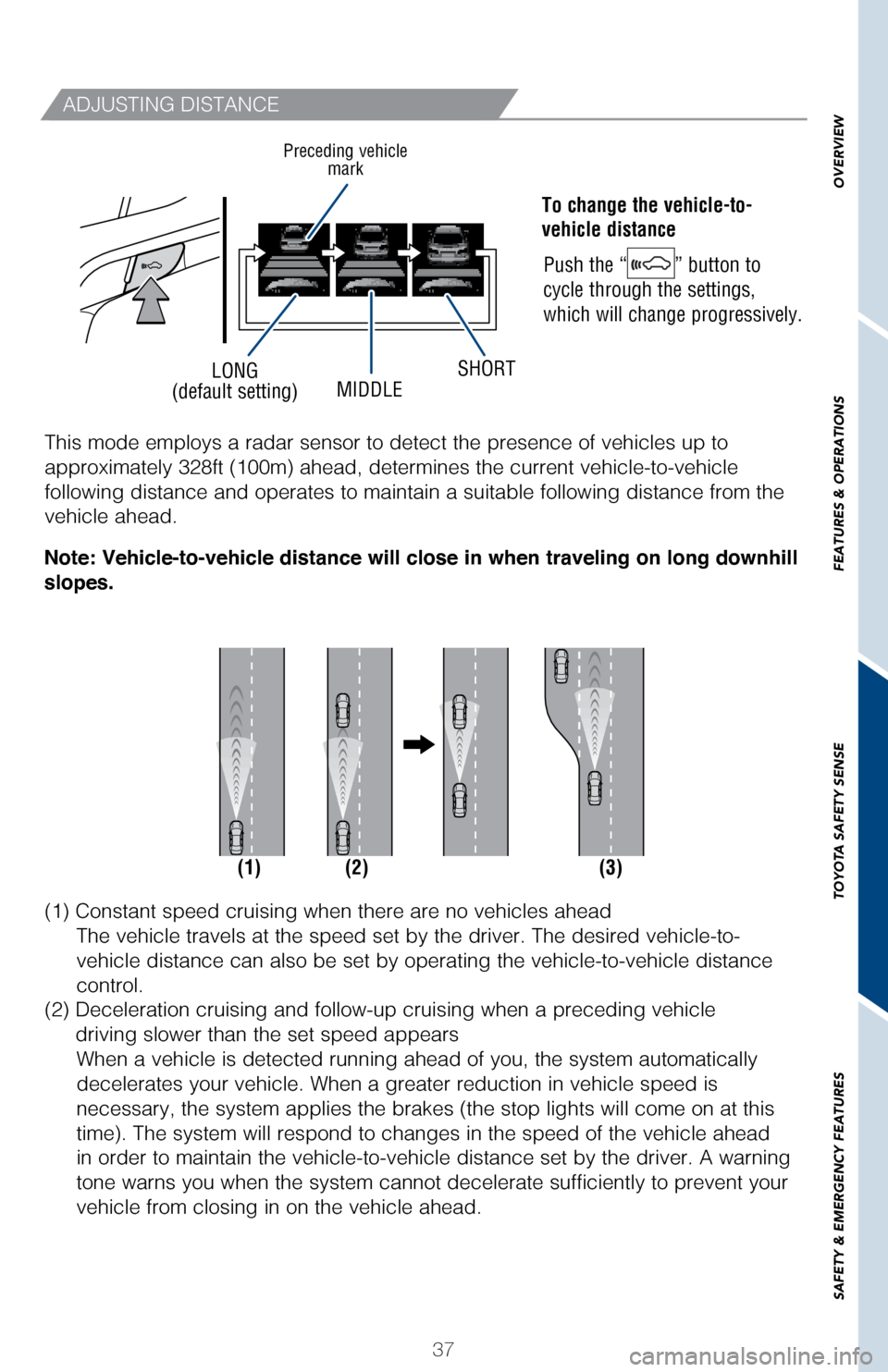
37
OVERVIEW
FEATURES & OPERATIONS
TOYOTA SAFETY SENSE
SAFETY & EMERGENCY FEATURES
LONG
(default setting) MIDDLESHORT
ADJUSTING DISTANCE
To change the vehicle-to-
vehicle distance
Push the “
” button to
cycle through the settings,
which will change progressively.
Preceding vehicle mark
(1) (2) (3)
This mode employs a radar sensor to detect the presence of vehicles up t\
o
approximately 328ft (100m) ahead, determines the current vehicle-to-ve\
hicle
following distance and operates to maintain a suitable following distanc\
e from the
vehicle ahead.
(1) Constant speed cruising when there are no vehicles ahead
The vehicle travels at the speed set by the driver. The desired vehicle-\
to-
vehicle distance can also be set by operating the vehicle-to-vehicle dis\
tance
control.
(2) Deceleration cruising and follow-up cruising when a preceding vehi\
cle
driving slower than the set speed appears When a vehicle is detected running ahead of you, the system automaticall\
y
decelerates your vehicle. When a greater reduction in vehicle speed is
necessary, the system applies the brakes (the stop lights will come on \
at this
time). The system will respond to changes in the speed of the vehicle a\
head
in order to maintain the vehicle-to-vehicle distance set by the driver. \
A warning
tone warns you when the system cannot decelerate sufficiently to prevent\
your
vehicle from closing in on the vehicle ahead.
Note: Vehicle-to-vehicle distance will close in when traveling on long downhill
slopes.
Page 40 of 54
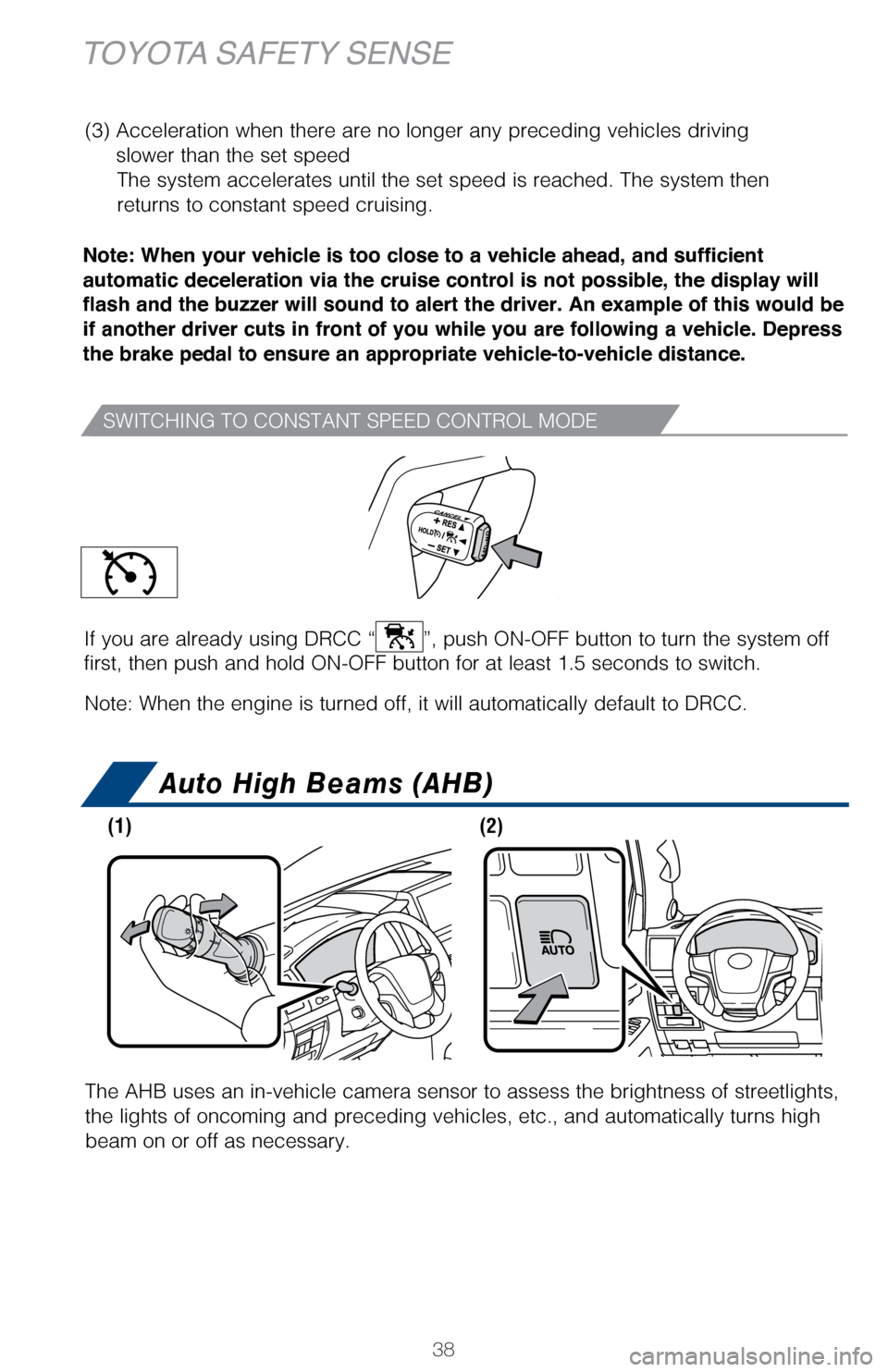
38
Auto High Beams (AHB)
TOYOTA SAFETY SENSE
SWITCHING TO CONSTANT SPEED CONTROL MODE
The AHB uses an in-vehicle camera sensor to assess the brightness of str\
eetlights,
the lights of oncoming and preceding vehicles, etc., and automatically t\
urns high
beam on or off as necessary.
(3) Acceleration when there are no longer any preceding vehicles drivi\
ng
slower than the set speedThe system accelerates until the set speed is reached. The system then
returns to constant speed cruising.
Note: When your vehicle is too close to a vehicle ahead, and sufficient
automatic deceleration via the cruise control is not possible, the display will
flash and the buzzer will sound to alert the driver. An example of this would be
if another driver cuts in front of you while you are following a vehicle. Depress
the brake pedal to ensure an appropriate vehicle-to-vehicle distance.
Note: When the engine is turned off, it will automatically default to DR\
CC.
If you are already using DRCC “
”, push ON-OFF button to turn the system off
first, then push and hold ON-OFF button for at least 1.5 seconds to swit\
ch.
(1) (2)
Page 44 of 54
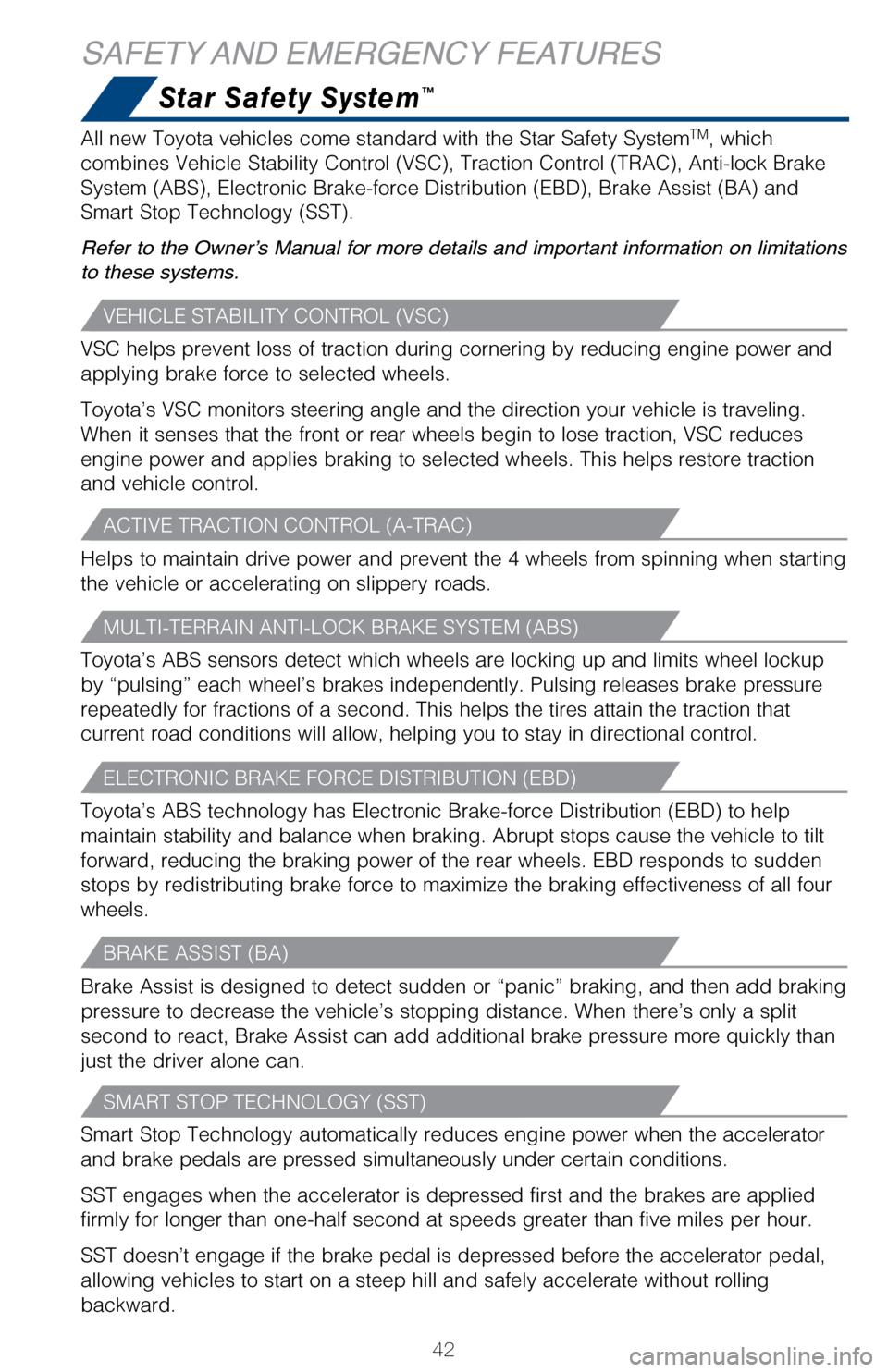
42
Star Safety System™
SAFETY AND EMERGENCY FEATURES
Smart Stop Technology automatically reduces engine power when the accele\
rator
and brake pedals are pressed simultaneously under certain conditions.
SST engages when the accelerator is depressed first and the brakes are a\
pplied
firmly for longer than one-half second at speeds greater than five miles\
per hour.
SST doesn’t engage if the brake pedal is depressed before the acceler\
ator pedal,
allowing vehicles to start on a steep hill and safely accelerate without\
rolling
backward. VSC helps prevent loss of traction during cornering by reducing engine p\
ower and
applying brake force to selected wheels.
Toyota’s VSC monitors steering angle and the direction your vehicle i\
s traveling.
When it senses that the front or rear wheels begin to lose traction, VSC\
reduces
engine power and applies braking to selected wheels. This helps restore \
traction
and vehicle control.
Toyota’s ABS sensors detect which wheels are locking up and limits wh\
eel lockup
by “pulsing” each wheel’s brakes independently. Pulsing release\
s brake pressure
repeatedly for fractions of a second. This helps the tires attain the tr\
action that
current road conditions will allow, helping you to stay in directional c\
ontrol.
Brake Assist is designed to detect sudden or “panic” braking, and \
then add braking
pressure to decrease the vehicle’s stopping distance. When there’s\
only a split
second to react, Brake Assist can add additional brake pressure more qui\
ckly than
just the driver alone can. Helps to maintain drive power and prevent the 4 wheels from spinning whe\
n starting
the vehicle or accelerating on slippery roads.
Toyota’s ABS technology has Electronic Brake-force Distribution (EBD\
) to help
maintain stability and balance when braking. Abrupt stops cause the vehi\
cle to tilt
forward, reducing the braking power of the rear wheels. EBD responds to \
sudden
stops by redistributing brake force to maximize the braking effectivenes\
s of all four
wheels. All new Toyota vehicles come standard with the Star Safety System
TM, which
combines Vehicle Stability Control (VSC), Traction Control (TRAC), A\
nti-lock Brake
System (ABS), Electronic Brake-force Distribution (EBD), Brake Assis\
t (BA) and
Smart Stop Technology (SST).
Refer to the Owner’s Manual for more details and important information on limitations
to these systems.
VEHICLE STABILITY CONTROL (VSC)
ACTIVE TRACTION CONTROL (A-TRAC)
MULTI-TERRAIN ANTI-LOCK BRAKE SYSTEM (ABS)
ELECTRONIC BRAKE FORCE DISTRIBUTION (EBD)
BRAKE ASSIST (BA)
SMART STOP TECHNOLOGY (SST)